PROCESS PLANT IN BOROSILICATE GLASS 3.3
Sigma borosil glass plants, pipelines & components are fabricated as per following international standards.
> BS EN 12585:1999 – Glass plant, pipeline & fittings compatibility & interchangeability.
> BS EN 1595:1997 – General rules for design, manufacture & testing.
The full range of standard components & associated equipment available is described in the following sections of the catalog.
CHEMICAL COMPOSITION OF BOROSILICATE GLASS 3.3
The Borosil Glass 3.3 used in the fabrication by SIGMA complies generally with the following chemical composition
| Component | % by weight |
|---|---|
| SiO2 | 80.6 |
| B2O3 | 12.5 |
| Na2O | 4.2 |
| Al2O3 | 2.2 |
| Others | 0.5 |
PROPERTIES OF BOROSILICATE GLASS 3.3
The very wide use of this material throughout the world in the chemical and pharmaceutical industries as well as many other allied areas, is mainly due to its chemical and thermal properties (see also ISO 3585) together with a great number of other benefits that distinguish borosil glass 3.3 from other materials of construction. These include special properties e.g
- Smooth non-porous surface
- Transparency
- Outstanding corrosion resistance
- No adverse physiological properties
- Neutral smell and taste
- Non-flammability
- Catalytic inertness.
CHEMICAL RESISTANCE
Borosilicate glass 3.3 is resistant to corrosion by almost all chemicals. This makes its resistance more comprehensive than that of other well-known materials. It is highly resistant to water, saline solutions, organic substances, halogens & many acids. There are only a few chemicals which cause noticeable corrosion of glass namely, hydrofluoric acid, concentrated phosphoric acid & strong caustic solutions at elevated temperature.
The curves in fig .1 show a maximum corrosion for different acids in the concentration range between 4 and 7 N (HCI for example at the azeotrope with 20.2 wt%). Above that reaction, speed decreases markedly so that the eroded layer amounts to only a few thousandths of millimeter after some years. There is, therefore, the justification for referring to borosilicate glass 3.3 as an acid-resistant material.
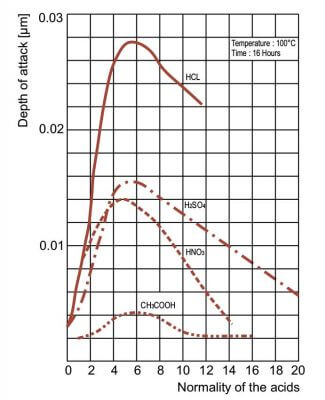
Fig. 1
Acid attack on borosilicate glass 3.3 as a function of concentration
It can be seen from the corrosion curves in fig .2 that the attack on the glass surface initially increase as the concentration of the caustic solution increases but after exceeding a maximum it assumes a virtually constant value. Rising temperatures increase the corrosion, While at low temperatures the reaction speed is so low that reduction of the wall thickness is hardly detectable over a number of years.
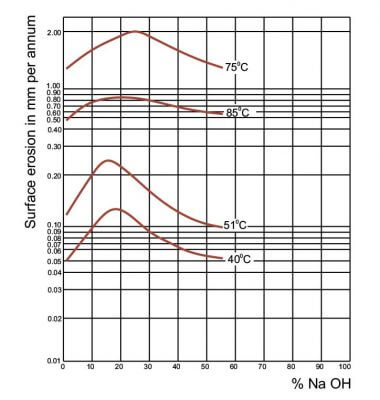
Fig. 2
Alkali attack on borosilicate glass 3.3 as a function of temperature & Concentration
OPTICAL PROPERTIES
Borosilicate glass 3.3 shows no appreciable light absorption in the visible range of the spectrum, thus it is clear & colorless. Transmission of UV light is significant in the middle spectrum compared to normal glass. Borosilicate glass 3.3 is ideally suited for photochemical reactions such as chlorination & sulphochlorination.
THERMAL SHOCK
Quick changes in temperature across the walls of glass components should be avoided during operation both indoors and outside. They result in increased thermal stress in the glass, which as described above, has an adverse effect on the permissible operating pressure of the plant components. Although it is not possible to give a definite figure applicable to all the operating conditions likely to be encountered in practice, a maximum permissible thermal shock of 120°C can be taken as a general guide.
PERMISSIBLE OPERATING TEMPERATURE
Borosilicate glass retains its mechanical strength and will deform only at a temperature which approaches its strain point. The practical upper limit for operating temperature is much lower and is controlled by the temperature differentials in the glass which depends on the relative temperature of the contents of the equipment and the external surroundings. Provided Borosilicate glass is not subject to rapid change in temperature, creating undue thermal shock, it can be operated safely at temperature up to 250°C
It must be realized that in complete plants, composed not only of borosilicate glass, but also include other materials such as PTFE. The recommended max. Operating temperature is 200°C. Operating temperatures may have to be modified so as to compensate for the effects of other factors such as pressure, thermal cycling, rapid heating & cooling etc.
At sub-zero temperature, the tensile strength of borosilicate glass tends to increase and equipment can be used safely at a temperature as low as – 50°C for Sigma Flat Buttress end components.
PERMISSIBLE OPERATING PRESSURE
The permissible internal operating working pressure depends on the nominal diameter size of glass components and external temperature. The maximum working pressure for a complete glass plant is determined by the lowest rated components in the system. All glass components are suitable at full vacuum over the entire temperature range. Bar g is a measure of absolute pressure.
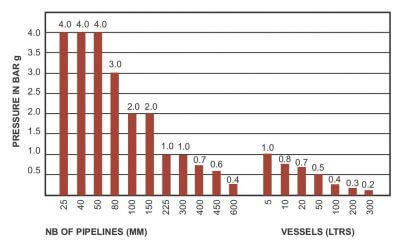
COMPOSITE MATERIALS
The last two decades have seen further developments of, particular corrosion resistant plant construction materials. Typical examples of these are PTFE, tantalum, titanium, graphite and of course, borosilicate 3.3 glass.
The combination of different corrosion resistant materials with the utilization of the specific advantages of each permits both safe and economic construction.
Borosilicate glass/PTFE
Borosilicate Glass with PTFE is of particular importance for the construction of glass installation. For example, In Seals, Bellows, Stirrers, Heat Exchangers, Column Inserts etc.
PTFE is used with Glass because of its excellent mechanical & thermal properties. They have near universal fluid compatibility. Wear life when compared with others is very low. Particularly PTFE is maintenance free and has cryogenic stability with the non-wetting property. Service temperature of PTFE is considered as – 50°C to + 200°C
ANNEALING
Annealing of glass is the process where the glass is heated and kept for a defined period of time to relieve internal stresses.
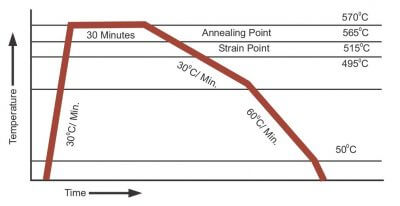
SIGMA FLAT BUTTRESS END
The glass process plant and pipeline components detailed in this catalog have standard Sigma Flat buttress end which is interchangeable with any international standard. We can also supply Ball & socket (Spherical end forms), and tapered type buttress end as per international standard on request.
The major dimensions of the Sigma flat buttress ends can be found in the table below, in conjunction with the illustrations alongside.
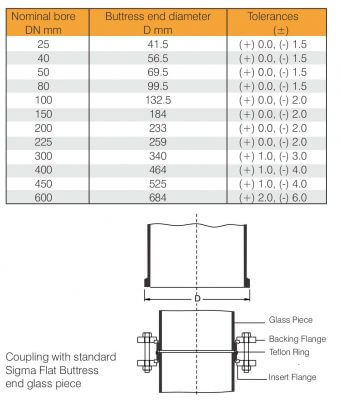
LENGTH & TOLERANCE OF GLASS COMPONENTS:
The tolerances on length L together with dimensions L1, L2 and L3 of components, unless otherwise specified for given components in this catalog.

FLANGE DIMENSIONS BALL SOCKET
(as per International Standard)
| d2 | R | ||
|---|---|---|---|
| DN | mm | dm | mm |
| 15 | 30 | 23 | 18 |
| 25 | 44 | 34 | 25 |
| 40 | 62 | 51 | 40 |
| 50 | 76 | 63 | 50 |
| 80 | 110 | 96 | 80 |
| 100 | 130 | 116 | 100 |
| 150 | 184 | 169 | 150 |
| 200 | 233 | 220 | 200 |
| 300 | 338 | 321 | 300 |
| 400 | 465 | 435 | – |
| 450 | 526 | 492 | – |
| 600 | 684 | 646 | – |
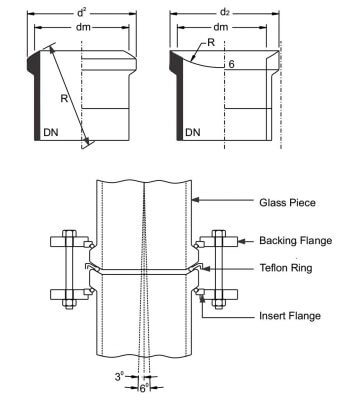
Coupling with standard Ball-Socket end glass piece Articulation is 0 possible to a maximum of 3, depending on the diameter
JACKETED COMPONENTS
SIGMA can supply jacketed version of all major components listed in the catalog, such as pipe and fitting, column components, heat exchangers and vessels. The glass jacket is sealed onto the component either by fusing, by silicon rubber or in a combination of both. The jacketed components help in saving energy by minimizing heat loss, and to maintain the product characteristics at the desired temperatures.
The permissible operating temperature
for the inner component:
| form
(-) 40° C component: |
|
| The permissible operating temperature for jacket: |
form (-) 40° C to 180° C |
| The permissible operating pressure: | 0.5 kg/cm²g to Full Vacuum |
STATIC ELECTRICITY
Electrostatic charge generation
Electrostatic charge generation in glass vessels and piping systems occurs due to:-
* The agitation of a low conductivity fluid in a vessel, or The flow of a low conductivity liquid through a piping system.
* The charge generated is retained in the fluid and due to the low conductivity cannot be dissipated (even if the fluid is in contact with a high conductivity pure metal vessel /pipe wall )
Charge generation will occur whether the vessel/ pipework is glass or of metal construction.
The charge generated depends on the actual operating conditions. For more information contact our technical department.



